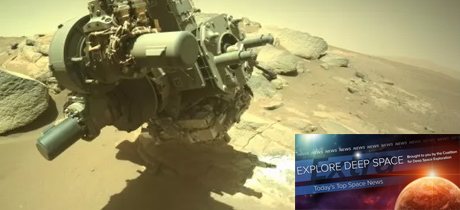In Today’s Deep Space Extra… NASA Administrator Bill Nelson says the agency is targeting no earlier than 2025 for returning humans to the surface of the Moon. Mars Perseverance rover is at work scraping away at a layered rock formation at Jezero Crater.
Human Space Exploration
NASA delays human lunar landing to at least 2025
SpaceNews.com (11/9): NASA is now targeting no earlier than 2025 for returning astronauts to the surface of the Moon with the Artemis III mission, instead of the previously proposed 2024 landing. In a news briefing on Tuesday, NASA Administrator Bill Nelson cited several factors for the latest target for landing at the Moon’s south pole with astronauts. He blamed legal actions challenging the agency’s April award of a single contract for development of an initial lunar Human Landing System (HLS), lack of funding from Congress, and technical difficulties. The first test flight of the Space Launch System (SLS) and Orion, Artemis I, which will send the Orion spacecraft around the Moon and back to Earth without astronauts is planned for February 2022. Artemis II, another test flight but with astronauts aboard, slips from April 2023 to May 2024. Nelson warned of China’s growing space capabilities as a threat. “The Chinese space program is increasingly capable of landing Chinese taikonauts much earlier than originally expected,” he said. “We are going to be as aggressive as we can be in a safe and technically feasible way to beat our competitors with boots on the Moon.”
Crew-3 mission cleared for launch
SpaceNews.com (11/10): Favorable weather is forecast for Wednesday night’s planned launch of the Crew-3 Dragon mission to the International Space Station (ISS) with NASA astronauts Raja Chari, Tom Marshburn and Kayla Barron, and the European Space Agency’s (ESA) Matthias Maurer. Liftoff from NASA’s Kennedy Space Center (KSC) is planned for 9:03 p.m. EST. With an on-time launch, the spacecraft named Endurance would deliver the four astronauts to the ISS on Thursday with a docking at 7:10 p.m. EST, for a six-month stay.
Russia to use orbital outpost at least until 2027-2028, says Roscosmos official
TASS of Russia (11/9): International Space Station (ISS) crew activities will continue at least through 2027-2028, Sergey Krikalyov, executive director for the Russian space agency’s Manned Space Programs, told a professional gathering on Tuesday. In July, Russia added the Nauka Multipurpose Laboratory Module to the ISS which is to be joined by the Prichal nodal module. NASA Administrator Bill Nelson has expressed support for continuing operations of the station through at least 2030. (Editor’s note: TASS is a Russian government-owned news source).
Space Science
Perseverance rover on Mars bites into layered rocks in hunt for clues of ancient water
Space.com (11/9): NASA’s Mars 2020 Perseverance rover is at work scraping away at a layered rock formation at Jezero Crater that may have formed long ago in liquid water. The rock formation would be the third site to be sampled by the rover since landing on Mars in February. Scientists are using Perseverance to collect samples of scientifically significant targets for return to Earth under a joint effort with the European Space Agency (ESA). Once on Earth, the samples would be studied for evidence of possible past biological activity on Mars.
Twins of NASA’s Perseverance Mars rover and Ingenuity helicopter are touring the U.S.
Space.com (11/10): While NASA Perseverance rover and Ingenuity helicopter explore Mars, life-size models of the spacecraft are on their own road trip on Earth to share the mission with the public. NASA’s “Roving With Perseverance” roadshow will see “twin” models of the Perseverance rover and its Ingenuity drone touch down at multiple U.S. locations in the coming months. Those who don’t live near one of the tour stops, or who prefer to participate remotely, will be able to join live virtual events. (The article includes details on tour dates and locations.)
Other News
U.S. interagency panel to update R&D strategy to tackle orbital debris
SpaceNews.com (11/9): An interagency group within the National Science and Technology Council will lead an updated research and development effort to deal with the mounting threat posed by orbital debris. The council reports directly to the U.S. president. The White House Office of Science and Technology Policy (OSTP) noted the council is soliciting public comment on the concern through December 31 and working toward release of a draft plan in 2022.

